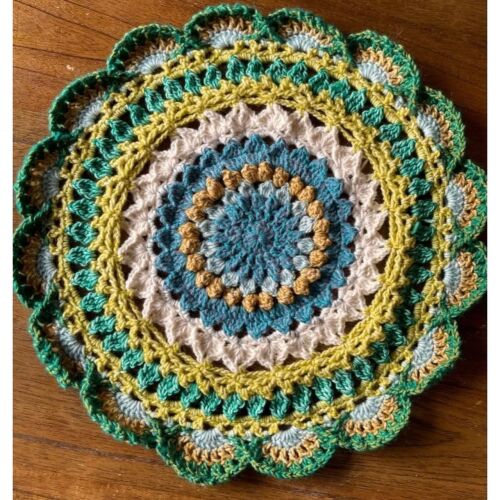Crocheting a flat circle relies on balancing the increasing circumference as you work outward. You achieve a flat circle by evenly distributing increases around the round. The idea is to add a fixed number of extra stitches with each round so that the circle grows smoothly without curving or ruffling.
I've found that magic number!
Click on this link to find how a simple formula works with UK trebles, Now you have the information you need to design and adapt your own mandala.
Want to crochet a pre-designed mandala? Here are four of the best.
-
Fiesta Mandala Blanket by Rachele Carmona
This vibrant mandala blanket showcases a hexagonal layout, combining intricate mandala designs into a cohesive and colorful piece. Rachele Carmona, the creative force behind CypressTextiles, offers this pattern in UK terms, guiding crafters through the process of creating a stunning, large-scale mandala blanket. View the pattern here.
-
Mini Meditative Mandala by Heather Gibbs
Designed by Heather Gibbs of Keep Calm and Crochet On UK, this mini mandala is perfect for adding a touch of tranquility to your space. The pattern is available in both UK and US terminology, making it accessible to a wide range of crocheters. This small project is ideal for using up yarn scraps and can serve as a decorative piece, coaster, or motif for larger projects.
-
Legacy Mandala by Nerissa Muijs
Nerissa Muijs, known as Miss Neriss, offers the Legacy Mandala, a beautiful design that combines various crochet techniques to create a stunning decorative piece. The pattern is written in UK terminology and is available for free on her blog, providing crafters with a delightful project that showcases intricate stitch work.
-
Easy Crochet Mandala Wall Hanging by The Crochet Swirl
This beginner-friendly mandala pattern is designed as a wall hanging, perfect for adding a handmade touch to your home decor. The Crochet Swirl provides clear instructions using UK crochet terms, making it accessible for those new to mandala projects. The simple yet elegant design allows for customization with different color choices to suit your style.
These patterns offer a variety of styles and complexities, all using UK crochet terminology, providing opportunities to explore the art of crocheted mandalas.
